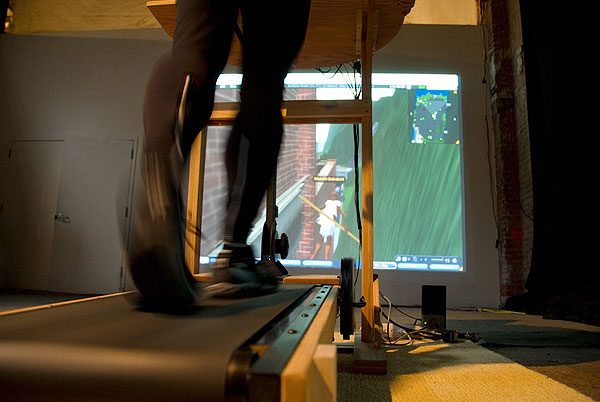You don’t have to wander long before hearing words like “cardio,” “endurance,” and “in shape” used in training lingo. Not a day goes by when I don’t answer some kind of question about these things, mostly as they relate to fat loss. “How would I handle blah blah blah, extra ‘cardio’ blab blah blah, to [...]

You don’t have to wander long before hearing words like “cardio,” “endurance,” and “in shape” used in training lingo. Not a day goes by when I don’t answer some kind of question about these things, mostly as they relate to fat loss.
“How would I handle blah blah blah, extra ‘cardio’ blab blah blah, to be ‘in shape’ blah blah blah, to ‘lose fat.’”
And it’s something that seeps into the tricking world, too. Is tricking cardio? Do you want it to be cardio? Do you need cardio for tricking? Or any sport? Or for fat loss?
Questions like these are so ambiguous because the word “cardio” has no meaning in relation to exercise. None. We have a lot of work ahead of us, so gear up. We’ll touch on just about every aspect of “cardio” you could ever want to feel up in the long run, but we need a system reboot first. We start here: what does cardio even mean?
The definition of cardio-
The prefix cardio- means heart. So “cardio,” when used to describe a certain type of exercise, means heart exercise. Problem: the heart beats every second of every day. So, yes—even as you read this, you’re “exercising” your heart.
Want to exercise your heart more right now without even standing up and moving around? Think about dying. You heart rate probably increased (which is what happens during “cardio”) with nothing more than a mere thought, and this is precisely why my day is ruined when I can’t get the thought of teeth grinding on a popsicle stick out of my head.
Here we showcase the trap 99% of us fall into without being taught otherwise: we succumb to reductionism, breaking down life into times of “non-exercise” and “exercise,” as if the human body and its processes turn on and off like a light bulb. If you’re one of these people, what’s really going to bake your noodle (I say in all of my The Matrix stealing glory) later on is realizing that the best way to ensure fat burning is to not exercising at all.
Is cardio running?
Perhaps you accept every second of the day being “cardio,” because you’re heart is always beating. You then go with cardio being activity that increases the heart rate beyond resting level; running being the common way to make that happen.
Alas, I’ve yet to see someone finish a set of 20 rep breathing squats that doesn’t think their body is going to be cast as Kane for the next Alien, with their heart cast soon after as the alien itself.

Many movements (not just running) are then covered under the umbrella of “cardio,” as lots of things increase heart rate. It’s an error to say that something muscular demanding (even creating!) doesn’t boost heart rate. From my long time experimentation with a heart rate monitor, I found out that standing barbell curls (yes, they were for the girls) jacked my heart rate more than . . . wait for it . . . deadlifts.
Clearly we have work to do; work that’s best done if you clear your current conception of cardio from your cranium.
The overlooked (and crucial) split of the anaerobic bucket
We started with the idea of cardio being heart rate increasing, so we should first know that our heart beats to deliver oxygen to places of need throughout our body. This is known as aerobic metabolism. We could get into the juicy bits of cellular respiration here, but let’s get serious: I don’t even care enough memorize that stuff; you won’t need it. What we do need to know, however, is that there is also anaerobic metabolism—a pathway that doesn’t use oxygen.
Most people stop after this divide. Aerobic on one side, anaerobic on the other. Saddle up on Shadowfax, and sail into the sunset. Right? But this divide doesn’t do our body justice—we need to further breakdown the anaerobic side of things, giving us the following:
- Alactic anaerobic / short term energy / 10-15 seconds / phosphocreatine
- Lactic anaerobic / mid-term energy / 60-90 seconds / glycolysis
- Aerobic / long term energy / hours / oxygen
This split of anaerobic metabolism is an often overlooked detail that will prove critical in sports context. My dad hasn’t exercise in a while, but he can still do one maximal vertical jump. But 50 consecutive vertical jumps? Probably not, and that’s where the split shines.
Redefining the buckets
Although we’ve created nice categories with durations for each energy system (which is what we will call these three categories, effectively delivering a kamehameha to the word “cardio”), each system is working in some capacity every second. Again, don’t fall for reductionism and breaking down exercise and rest into completely dissimilar things. Just because you aren’t exercising doesn’t mean your aerobic system is snoozing. In fact, as you read this, your aerobic system (yes, that same guy that’s typically associated with “cardio”) is providing your body with the fuel needed to survive.
To make things easier, here’s a simplified (yet telling) relationship of how the energy systems pan out in terms of % contribution if you were to start out sprinting in a straight line, not stopping until you passed out from exhaustion.
- alactic anaerobic = going at start of explosive exercise until your muscles start burning
- lactic anaerobic = muscles burning, trying to maintain high intensity
- aerobic = high intensity can’t be maintained, huffing and puffing begins and activity slows
And, of course, the aerobic system extends into everyday life. When you roll into work or school only to have someone ask you why you look so tired, tell them it’s because you just got done using the aerobic system for eight hours.

The scientific juice of the systems
Let’s start with the obvious: there seems to be an interesting relationship between intensity of effort and length of use among the three energy systems. For starters, know that they don’t switch because of fatigue. It’s not: I’m tired, switch to a new one. It’s: I can’t meet the energy demand, switch to a new one, can’t get energy as fast because the system is slower, which then manifests as fatigue.
We need something called ATP for energy. When ATP gets used, the alphabet monster turns ATP into ADP. In order for ADP to be reused for energy, it has to become ATP again. This, in essence, is the job of the energy systems: to replenish ATP. And each energy system has a different way to make that happen.
For a short term, high effort activity (a few vertical jumps, a 40 yard dash, a trick, a couple of repetitions of heavy squat), the alactic anaerobic branch uses phosphocreatine to restore ATP. The good part of this is that phosophocreatine restores ATP quickly; the bad part is that we have a reallllllyyy limited supply — like 10 seconds worth. This is why you can’t maintain a continuous absolute max intensity for long.
Note: this is also why athletes supplement with creatine—it gives them just a little bit more to use. A little bit might seem small, but considering Olympic gold medals are decided by fractions of seconds, a little bit goes a long way.
If after the phosphocreatine supply is just about exhausted, and you’re still trying to maintain absolute max effort, the lactic anaerobic system becomes the main contributor to ATP magic by gobbling up stored carbohydrates (glycogen) within the body.
A weird (beyond the need to know) process breaks down the glucose into pyruvate. Pyruvate, combined with excess protons (a consequence of turning ATP to ADP), makes for one acidic environment. In a process, which one again I won’t pretend to know about, the pyruvate absorbs some protons and then turns into lactate. This allows for the continued use of glycogen.
Note: the lactate isn’t what causes the burning sensation—it actually neutralizes the burning. It’s the protons and pyruvate that create the acidic environment.
Where the alactic anaerobic pathway rapidly replenished ATP, the lactic anaerobic pathway is slower. It takes longer to replenish energy, and absolute maximum intensity drops. This is more suited to the sports discussion, but the word absolute is important here. When using the lactic anaerobic pathway, subjective (your perceived) intensity will still be very high. But performance, from an absolute standpoint, will drop.
Just a quick example: running 800 meters. The first 200 would be fast and effortful. Maybe you run it in 20 seconds because you’re an Olympian. The next 200, you ran 22. Next 200, 25. Final 200, 27. Or simply consider that the current 200M world record is just shy of 20 seconds, and the 800M world record is 100 seconds. 200M x 4 = 800M. Yet 20 seconds x 4 = 80 seconds. See how it doesn’t add up?
Although you might be giving it your all (subjective max) and really perceive the work as tough, you won’t be running at your absolute max.
If you kept running as fast as subjectively possible (which wouldn’t be very fast at this point— you’d be reduced to a crippled jog even though, once again, subjective effort would be through the roof), you’d enter the the realm of the aerobic system, which is the slowest energy system.
If you’re pushing yourself and heavily taxing aerobic system, chances are you’ll still be using glycogen. But since the intensity is lower yet, the pyruvate can take the aerobic pathway and not get mixed up with all of that lactate business.
At a much lower intensity (activities of daily living), the body and the aerobic system use primarily fat to sustain itself, as fats are much more energy rich, but also require time to be broken down — time that we often don’t have in the midst of exercise.
Some immediate thoughts
This is a rather crude look at how things work, but it serves the purpose. Keep in mind that our example was a little unconventional, too. Tricking — among other sports — isn’t about running at maximum intensity until passing out. There are short explosive bursts followed by downtime — the implications of which will be saved for another day.
Just because you’re doing something aerobic doesn’t mean you’re using fat. If your aerobic intensity is high, you might be using carbohydrates. And that’s why endurance athlete “load” carbohydrates — to increase glycogen storage. Once glycogen runs out, you’re toast. Runners often call this “hitting the wall” or “bonking out.” Most people that strength train or trick will never bonk or hit a wall of glycogen depletion because we aren’t doing a continuous activity.
With the thought of runners carb loading, we see that nutrition mingles its feet in this conversation. Eating in itself can shift your metabolism away from fat burning to vary degrees depending on types of foods eaten. Here’s some interesting food for thought along those lines.
Changing metabolism through nutrition…?
The aerobic zone, when taken to a high(er) intensity, uses carbohydrates because they’re broken down faster than fats. Sadly, from an efficiency standpoint, you want fats to be fueling activity because fats are a much richer source of energy. You have much more fat than you do stored carbohydrates, even if you’re sporting a six pack.
There are some people that claim a low carbohydrate ketogenic diet can fundamentally alter your metabolism to preferentially use fat for fuel at a higher intensity than someone privy to eating carbs (who would use glycogen). Rationale: the low carbohydrate environment shifts the body into more of a consistent fat burning mode, as it can’t be generous with carbohydrates (or glycogen for that matter) because they aren’t being eaten. In other words, if you eat carbohydrates as your primary energy nutrient, your body uses carbs. If you eat fats as your primary energy nutrient, your body uses fats.
True? Meh. Maybe? On one side, people rip apart the studies done that show this metabolic shift, right after they mention the utter lack of high class devout low carb aerobic athletes. On the other side, there are guys like Peter Attia of Eating Academy, who are not only motivated enough to experiment with things, but also have the means to run self conducted tests. (And his show said metabolic shift.)
It sort of makes sense—the body wanting to “save” glycogen for when it’s absolutely needed, and using the much more efficient (and prevalent) source of fat.

It’s tough for a skeptic like myself to be dogmatic about any one approach, so I’ll just say the thought of the latter is interesting with big implications. I’m a believer in what Nassim Taleb calls Black Swans, fueled by Karl Popper who said:
…that you could not know with any certainty that a proposition was true; you could only know that it was not true.
– Malcolm Gladwell, Blowing Up
In other words, there are people out there that do well on low carbohydrate diets on some training programs, just as there are people that do well on high carbohydrate diets. And as long as there is one (even if there is currently none, for that matter), you can’t rule anything out.
Be your own student here. Experiment. Find out how your body responds in different nutritional environments. Try not to tell yourself any preconceived stories, either.
Are you in the 12.6%?
We can talk energy for a long time, but there’s a good chance only 12.6% of readers made it this far, so we’ll try to wrap up the cardio confusion with thoughts on how all of this relates to fat loss and body composition.
Without getting formally tested, we never really know what we’re using for ATP regen magic. The extremes are easiest for assumptions. Laying in bed, eight hours after your last meal—probably fat. Doing a one rep max squat—probably alactic anaerobic. Doing a 400-800M sprint—probably lactic anaerobic.
In the middle, things are cloudy. And this is why I recommend trying to bring some clarity by avoiding noise, but it all depends on your goals.
Consider that the body often adapts opposite of what actually goes down. If there was a half filled cup of water on the table, and you emptied the cup, the story doesn’t end. You used the water; you must have needed it, so the body will probably refill the cup back to half . . . and a little beyond.
Train and break the muscles down, the muscles build back up . . . but bigger. Train and deplete muscle glycogen, stores replenish . . . and even increase. This isn’t to say you’re going to get fat from any one type of exercise that “burns fat,” because there’s more to consider than energy use. (Although it does hint to why most human bodies want to store fat.) The body is a much smarter cookie that we give it credit for, and it knows how to delegate nutrients and processes based on what’s been thrown its way.

Marathon runners aren’t gangly because they use the aerobic system, they’re gangly because every last piece of tissue that has a metabolic cost outside of sustaining mild intensity contractions for a lonnnggggg time is simply wasted energy. You don’t need big muscles for sustaining mild intensity contractions. You need big muscles for aggressive, violent contractions.
Alas, the sprinter vs. marathon runner comparison is a debate for another day, so all of this is to say that you have to consider the totality of interpretations the body makes, and then how it would delegate its resources. If you want to gain as much muscle possible, it makes little sense to also do a repetitive mild intensity activity in which muscle is nothing more than a metabolic liability. That’s not to say you can’t, but rather that you have to accept the consequence of noise and the body spreading a finite amount of adaptation across different ends.
The simplest way to make this happen, if you’re interested in more of an athletic physique, is to focus on the type of things that are powerful enough to actually build muscle (barbell exercises) and things that can’t be mastered with a lot of useless fat mass (bodyweight exercises, sprinting).
Fat loss specific work shouldn’t contradict muscle, and there are many possibilities for this. Maybe a short muscularly intensive “metcon” once or twice will help the cause, even though it’s likely a carbohydrate dominant activity. Walking is likely your best bet because it doesn’t interfere with recovery, can be done often, has no muscle contradiction, and is your best bet for actually using fat to churn through aerobic metabolism with a higher-than-normal heart rate.
Even I’m confused, so don’t worry
If you feel like you just fell down a rabbit hole of confusion, don’t worry. I’m confused, too. So many things work, so many different goals exist, and so many physiological factors play into the potential outcome. Humans are emergent; repeat that as you sleep tonight.
I know we didn’t even get into the importance of nutrition as it relates to fat loss, but I think it’s about time we realize that many things work for fat loss. That’s not the important part though. The important part is using what’s right for you at the right time — something that won’t destroy your performance ambitions, either.
That “metcon” mentioned above? Could be useful . . . unless you think it’s to be done on a “rest day,” and then that impairs your recovery for truer muscle building work.
Right for you; right time for you.
Having some kind of sporting goal helps here, because it guides things further. It’s not just about fat loss or muscle gain, it’s about rewiring your body “underneath the hood.”
We’ve come a long way to get here, but I hope you see why asking about “cardio” doesn’t quite cut it, and why I have an existential melt down when a vague cardio question comes my way — all 3,000 of the words in this article (and many many more) swim throughout my brain. And in light of that, I think it’s time to head to sleep. You know, a mans gotta train his aerobic system every once in a while, right?
+++++
Photo credit: treadmill smart cookie black swan